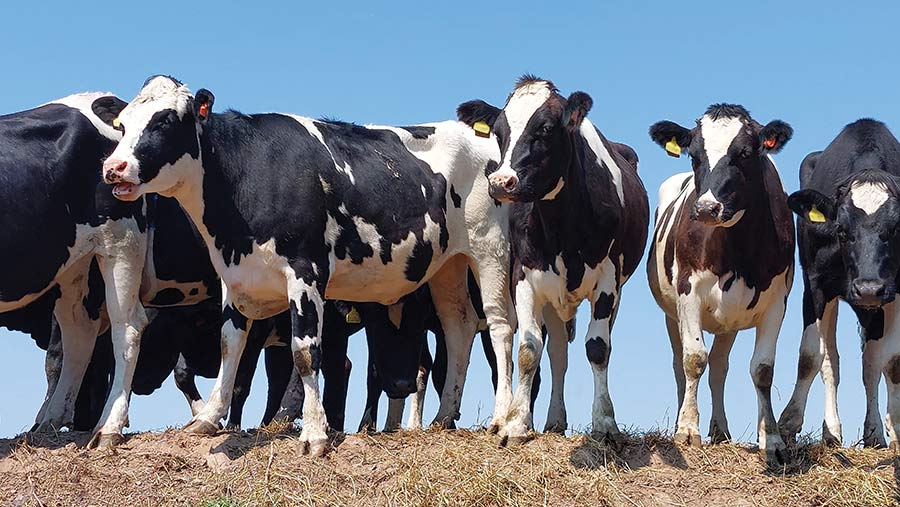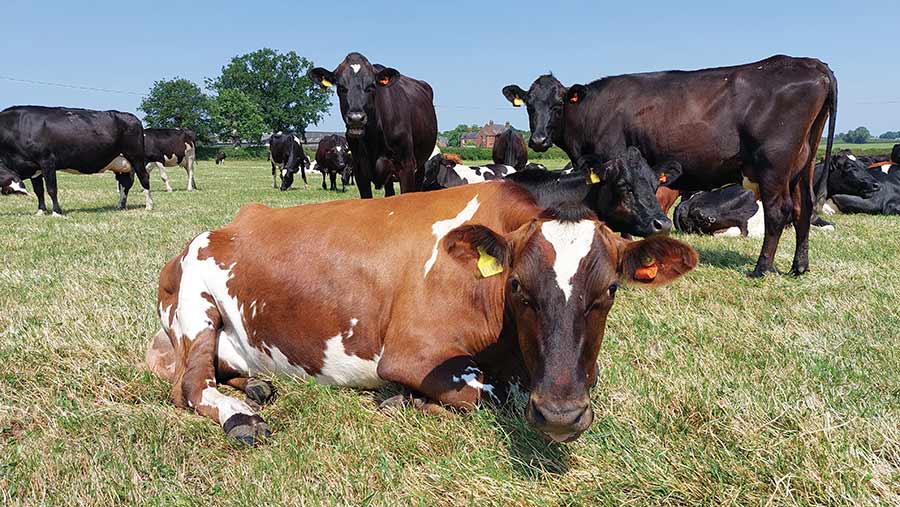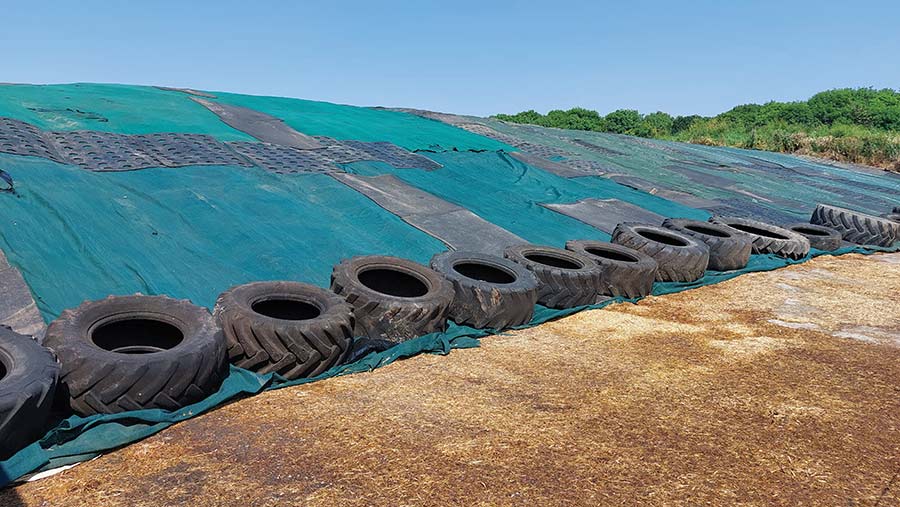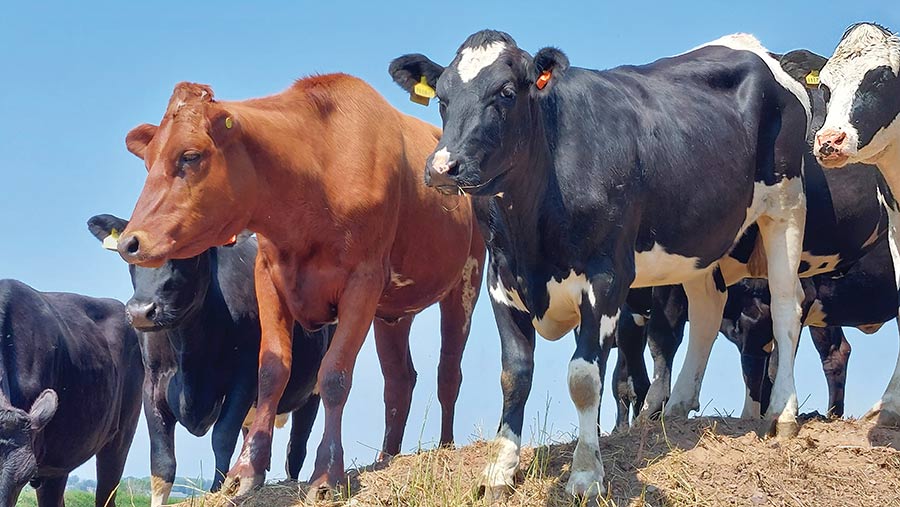Silage calculations save on feed for autumn block-calver
 © MAG/Shirley Macmillan
© MAG/Shirley Macmillan For organic grower Jonathan Hughes, working out how much is needed to get through winter, including wastage and contingency, then filling clamps with home-grown forage, hits the sweet spot rather than taking the risk buying silage on the spot market.
See also: Farmer Focus: Drought fix after 3.5p/litre forage spend
His calculations show that he needs to clamp 2.75t dry matter (DM) a cow a year – a total of about 1,700t DM for his cross-bred herd.
The autumn block-calving system at Clares Barn Farm, Twycross, is based on grazing as much grass as possible.
And it is designed for a farm that burns up in summer. Flexible grazing means stock can be removed from the platform to graze elsewhere.
This reduces the demand for grass and avoids buffer feeding. In summer, cows are in late lactation and the herd is being dried off as grass growth grinds to a halt.
Clares Barn farm facts
- 625 cross-bred cows
- 320 heifers
- 425ha (1,050-acre) organic farm
- Includes 180ha (445-acre) grazing platform
- 93ha (230-acre) second farm
- 6,800 litres a cow
- 1.2t cake
- Turnout 7 February
- Fully housed 31 October
- 1.7 livestock units/ha
“Autumn block-calving suits the weather pattern, and our heavier soils provide more of a safety net for drought,” says Jonathan, who farms in partnership with his brother, Alistair.
“Far-off dry cows graze standing hay [or silage grass with haylage bales] and, three weeks before calving, move onto 2kg DM wholecrop, plus 1kg of organic rapemeal and a liquid mineral system.”
Other strategies to reduce feed demand in a drought include selling cull cows earlier and grazing silage land, rather than clamping it.
The farm is ring-fenced and set up so that every field on the 425ha (1,050 acres) can be grazed, with cows walking up to 2km for milking.
At the same time, milking is dropped to 10 milkings in seven days from June to August, reducing energy requirements and saving time for the team.
Despite these measures, last year’s drought (when organic clamped silage reached £220/t DM) convinced Jonathan that an organic farm is highly prone to fluctuating forage prices.
As a result, feed security has become a priority and one that requires planning, he says.
“Drought was one year in six or seven; now we are looking at one year in three, so we need to change our budgets.
“A conventional farmer can buy any forage – being organic, we are limited, and prices are even more inflated in a drought.
“There is also the issue of quality. To combat that, we are growing all forages in-house to improve our resilience. Also, if we have built a buffer of silage, we can grow combinable crops for home use or sale.”

© MAG/Shirley Macmillan
Calculating needs
Jonathan starts his budgeting for grazing and silage yields by using the farm’s five-year average for grass growth.
Since starting organic conversion five years ago, he has not generated enough data to see what a normal year looks like, so he is still experimenting.
“We were growing 12t DM/ha of grass conventionally, ranging some years from 11t DM/ha to 14t DM/ha. Last year, growth rates were affected by the drought, and we grew just 7t DM/ha,” he says.
Rather than simply try to fill up the four silage pits and hope for the best, or store a year’s worth of forage as an insurance policy, Jonathan works out how much silage he needs.
He measures what is left in the clamps – if anything – then aims to grow and clamp the difference.
He uses an online feed budget spreadsheet to calculate separate winter and summer feed requirements, working back from peak lactation.
A flat rate of 6.5kg a cow a day of concentrates is fed for a yield of 27 litres a cow a day (2.2kg milk solids a cow a day).
For the herd’s cross-bred cow size, the total DM intake is 21kg/day, which leaves 15kg DM a cow a day to be supplied by silage.
Over a winter, this adds up to 2.5t DM a cow.
“Incorporating the shoulders of our grazing season, the average winter equates to five months of full housing. In a hard winter, the budget will extend to six months, so we would always aim to have this in stock approaching the winter,” Jonathan explains.
“Cows would be grazing 6kg DM a cow a day in early February as we reduce the silage. In a wet spring, we might keep cows in to avoid poaching, and we also feed some silage in September and October.”

© MAG/Shirley Macmillan
Reducing risk
Jonathan holds back 0.5-0.75t DM a cow in case of drought (based on a cow eating 16kg DM/day for up to 45 days).
This is costly, he admits, but says that a higher milk price usually pays for it, and it will be cheaper than buying in.
He also allows for 10% wastage on the total 2.5t a cow winter ration.
This means clamping 2.75t DM a cow each year, or 1,700t DM to supply the herd.
In addition, he budgets 7.5kg DM a head a day for breeding heifers, plus 10% wastage, which equates to about 1.16t DM a head over winter.
With half of this forage usually coming from grass silage, the goal is to take first cut in the first week of May.
Farming organically, however, means relying on slurry as a fertiliser, letting the clover do its work, and accepting smaller yields as a result.
To offset this lower yield and be more self-sufficient in the long term, the business expanded its acreage last year by taking on a second organic unit.
This 93ha (230-acre) farm, five miles away, grows grass, lucerne, maize, fodder beet and wholecrop barley to spread risk and benefit from a combination of forages layered in the forage box.

© MAG/Shirley Macmillan
Targeting first cut
“We use slurry and clovers to feed the grass plant. Our first slurry application is in late February/early March, and the second in early April.
Clover gets going then, as it only comes to life when the soil temperature gets to 9C.
“We make a big first cut off 223ha [550 acres] of quality, leafy grass. We aim for a second cut in a good year, but from about half the acreage, and the rest is grazed. Second cut feeds heifers over winter.”
First cut produced 1,000t DM this year; 500t DM is expected from lucerne and 60t DM from the fodder beet.
Jonathan says he is still trying to find his feet with organic maize, but budgets 10-12t DM/ha for the wholecrop.
Because he budgets for a good year and an extreme one, as well as separate winter and summer feed requirements, he has a framework to build on.
“It’s about having a plan. You can be that person buying in hand-to-mouth and paying through the odds for silage, or have stock on hand as an insurance policy. Working it out means you have the evidence. You can always sell a surplus of silage.”
